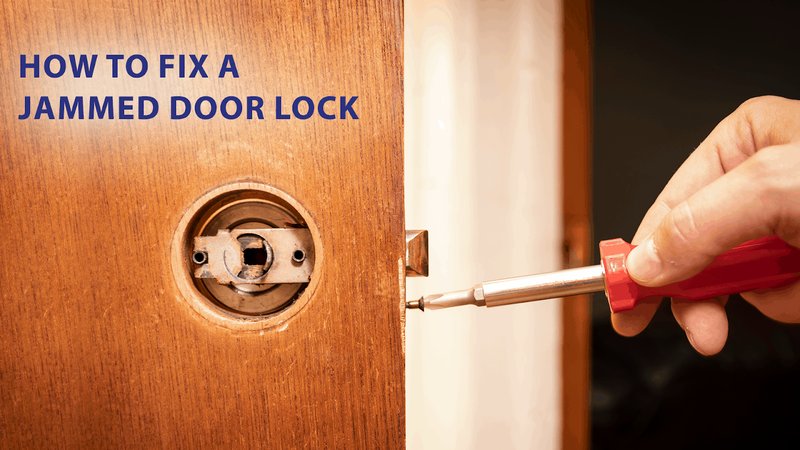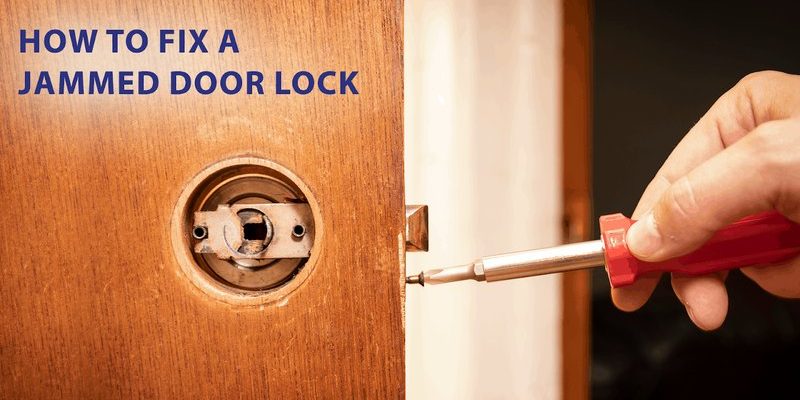
Think of your deadbolt like a well-oiled machine, or at least, that’s how it should be. When everything lines up—internally and externally—it should slide closed with one simple twist. But when it sticks, grinds, or just won’t budge, especially when there’s no pressure from the door frame, it’s usually a sign that something inside the lock or bolt is off. Whether you’re dealing with a standard Kwikset, Schlage, or basic hardware-store brand, most deadbolt issues boil down to the same handful of culprits.
Let’s break down what’s really happening, why it matters, and exactly how you can fix a deadbolt that stubbornly resists locking—even when the door isn’t the problem.
Understanding Why Deadbolts Get Hard to Turn (Even With the Door Open)
Here’s the thing: when a deadbolt refuses to work smoothly with the door wide open, it takes the door and frame alignment out of the equation. That means the trouble is almost always inside the lock mechanism itself. Normally, the bolt should slide in and out of its housing with almost zero resistance. If it doesn’t, the moving parts inside may be gunked up, dry, or just plain misaligned.
Most deadbolts work the same way, no matter the brand. There’s a cylinder (what your key turns), a bolt that extends and retracts, and a few small internal parts like springs and tailpieces. If any one of these pieces gets worn out, rusted, bent, or even a little dirty, the motion gets stiff. Imagine trying to ride a bike with a rusty chain—same idea.
Sometimes, it’s not even wear and tear. High humidity, temperature shifts, or a clumsy installation can all play a role. If you just replaced the lock or had it rekeyed, something might not be lined up quite right. In rare cases, a cheap or universal deadbolt that isn’t quite a match for your door can be at fault, too.
Signs Your Deadbolt Has an Internal Issue
It’s important to know the difference between a deadbolt that’s hard to lock because of the door (like if your frame is misaligned) versus one that’s fussy even when the door is open. Here’s how you can tell:
- Deadbolt is stiff with the door open: This points to trouble inside the lock, not the alignment.
- You hear grinding or feel roughness: That’s likely metal scraping, debris, or a dry mechanism.
- Key is hard to turn in the lock (even off the door): If you remove the lock and it’s still tough, it needs internal attention.
- Lock feels loose or “clicky” inside: Worn or broken internal parts can make things catch or slip.
You might be tempted to blame the key or the door itself, but if it’s acting up while the door is open, it almost always means something is binding, dirty, or out of alignment inside the deadbolt hardware.
Tools and Supplies You Might Need
Before you start poking around, let’s run through what you’ll probably need. Most deadbolt fixes are straightforward, but having the right tools on hand makes things less frustrating.
- Screwdriver set (usually Phillips and flathead)
- Graphite lock lubricant (avoid WD-40, which can attract dust over time)
- Soft cloth or paper towel for cleanup
- Replacement parts (only if you spot something clearly broken)
- Small brush (like an old toothbrush) for cleaning out debris
- Needle-nose pliers (sometimes handy for springs or pins)
Most household deadbolts, including popular brands like Kwikset and Schlage, are designed for easy disassembly and maintenance by beginners. If you run into something unusual, check the manufacturer’s code or instructions.
Step-by-Step: How to Fix a Deadbolt That’s Hard to Engage With the Door Open
Let’s walk through the process from start to finish. Don’t rush—going slow helps you spot what’s wrong and avoid damaging anything.
1. Remove the Deadbolt From the Door
Start by unscrewing the lock from the inside of the door. Most deadbolts have two screws on the interior face. Gently pull both sides of the lock apart. You’ll see the bolt and housing slide out as a unit.
Tip: Keep all screws in a cup or tray so nothing rolls away.
2. Inspect the Internal Mechanism
With the lock off, try engaging the bolt by turning the thumbturn or using your key. If it’s still stiff, you’ve confirmed the problem is inside the lock. Look for obvious signs of trouble:
- Dirt, dust, or debris packed inside the bolt housing
- Visible rust or corrosion
- Bent, broken, or loose parts—a tailpiece that moves too much, or a spring that’s out of place
3. Clean and Lubricate
Use a small brush to remove debris from inside the lock. If you spot old lubricant, dirt, or rust, wipe it away gently. Then, apply a small amount of graphite lubricant into the keyhole and moving parts—never soak it. Turn the thumbturn or key several times to spread the graphite around.
Honestly, a little graphite goes a long way. Too much just clouds up the works, so use it sparingly.
4. Reassemble and Test
Put the deadbolt back together and mount it on the door. With the door still open, test the lock several times. If everything now moves smoothly, you’ve solved the issue. If not, you may need replacement parts or a new deadbolt.
When to Replace vs. Repair a Difficult Deadbolt
Sometimes, no matter how carefully you clean or lubricate, a deadbolt just refuses to cooperate. At that point, it may be time for a replacement. Here’s what usually tips the scales:
- Heavy rust or corrosion inside the lock—this often means the internal springs or pins are shot.
- Bent or broken moving parts you can’t realign or fix with pliers.
- Older locks (10+ years) that have simply worn out with daily use.
- If you’ve tried everything and the bolt still binds with the door open.
The good news is, new deadbolts are pretty affordable and easier than ever to install. Universal models can be swapped in with just a screwdriver, but you’ll want to double-check the brand and size match to your door. Schlage and Kwikset are two of the most reliable options with clear instructions.
Comparing Deadbolt Brands: Are Some Easier to Fix?
You might be wondering if a certain deadbolt brand is easier to repair or less likely to jam. In my experience, most name-brand locks—like Schlage, Kwikset, and Yale—use solid, straightforward designs that are beginner-friendly for troubleshooting.
- Schlage deadbolts tend to have robust, metal internals and clear assembly layouts. If you ever need to reset or code a Schlage smart lock, their manuals are excellent.
- Kwikset locks are known for easy re-keying and simple, modular parts. They respond well to basic cleaning and lubrication.
- Universal or off-brand deadbolts can be hit or miss. Some work fine, others never quite fit or sync with your door, making troubleshooting more fiddly.
If you’ve got a universal deadbolt that’s always been hard to turn, consider swapping it for a major brand. It’s less about the “code” or model, and more about smooth, reliable internal parts.
Other Deadbolt Problems Worth Checking
While a deadbolt that’s hard to engage with the door open is almost always an internal issue, there are a couple surprises that can trip you up:
- If your key is worn or doesn’t match the lock code perfectly, it can cause sticking—even off the door. Try a freshly cut key if you have one.
- If you just rekeyed or installed the deadbolt, double-check that all parts are synced and seated correctly. A misaligned tailpiece or spring can instantly jam things up.
- Rarely, a lock battery (on electronic deadbolts) might be weak, causing sluggish movement. Swapping the battery can revive a “dead” feeling smart lock.
Let me explain: don’t overlook the obvious, especially if the deadbolt was working fine until recently. Any little change—new key, new install, maybe even a reset—can throw things off.
Deadbolt Maintenance Tips to Prevent Future Problems
Once you’ve fixed your stubborn deadbolt, a little regular care goes a long way. Most people never think to maintain their locks until something goes wrong, but spending a few minutes every few months can prevent a lot of hassle.
- Lubricate every 6–12 months with a dab of graphite powder. Skip the oily sprays and stick to dry lubricants.
- Wipe down the lock and bolt if you notice dust or grime building up.
- For smart deadbolts, check the battery and code settings regularly so you’re not locked out at the worst moment.
- After any rekey, reset, or new install, test the lock repeatedly with the door open to be sure it’s running smoothly before trusting it with your security.
A quick, simple routine keeps things in sync and saves you from future lockouts or late-night DIY fixes.
Final Thoughts: Quick Wins for a Smoother Deadbolt
Dealing with a deadbolt that’s hard to engage—even with the door open—can be frustrating in the moment, but most fixes are totally doable with a few basic tools and a little patience. Whether your lock is a sturdy Schlage, a handy Kwikset, or a budget universal model, the core principles stay the same: keep things clean, keep things tight, and make sure every moving part is in good sync.
If you’ve tried all the steps above and things are still not working, don’t stress—sometimes, a fresh deadbolt is the safer, smoother way forward. And honestly, once you’ve gone through this process, you’ll know exactly what to look for next time your lock gets stubborn. Here’s to smoother, safer doors—and a whole lot less wiggling and jiggling next time you head out.
